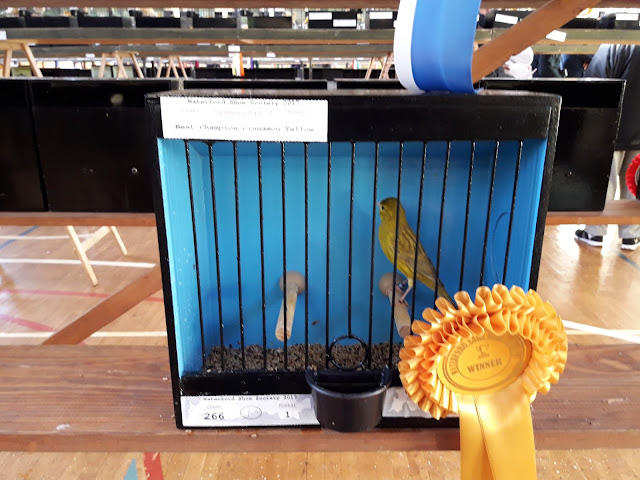Οι παπαγάλοι συγκαταλέγονται ανάμεσα στα πιο έξυπνα είδη πουλιών στον
κόσμο. Αυτό το πολύχρωμο και έξυπνο πτηνό έχει αιχμαλωτίσει τις καρδιές
και τις φαντασίες χιλιάδων ανθρώπων. Η πρώτη εικόνα που μας έρχεται στο
μυαλό όταν σκεφτόμαστε έναν παπαγάλο είναι αυτή που κάθεται πάνω στο ώμο
ενός πειρατή, πολλές φορές έχοντας το ένα μάτι του καλυμμένο. Η
συγκεκριμένη εικόνα, όμως, όσο συνηθισμένη και αν είναι, δεν είναι πολύ
δίκαιη για τους παπαγάλους. Στην πραγματικότητα είναι πολύ πιο αστείοι
και ενδιαφέροντες, από το να κάθονται στον ώμο ενός πειρατή, και απαιτούν πολύ φροντίδα, αγάπη και εκπαίδευση για να αναπτυχθούν και γίνουν αυτό που μπορούν να γίνουν.Μεγαλυτερη αποδειξη του μεγαλου δεικτη ευφυιας των παπαγαλων και του ποσο παιχνιδιαρηδες ειναι , αποτελει ο παπαγαλος Caique .
Οι Παπαγάλοι Caique (προφέρεται Κάικ) είναι ένα σχετικά μικρό είδος παπαγάλου με εκπληκτικά χρώματα. Το μέγεθός τους δεν ξεπερνά τα 25 εκατοστά ενώ το βάρος τους κυμίνεται μεταξύ 150 και 170 γραμμαρίων.
Η καταγωγή τους είναι από την Νότιο Αμερική. Μπορεί κανείς να τους βρει στις τροπικές ζώνες και ειδικότερα κοντά σε υδροβιότοπους. Ζουν συνήθως σε μικρά κοπάδια έως 30 ατόμων. Αναπαράγουν πολύ δυνατούς ήχους κατά την διάρκεια της ξεκούρασης τους στα δέντρα ή των πτήσεων τους από το ένα δάσος στο άλλο.
Όμοια με τους μεγαλυτερους παπαγαλους,τους macaw , ένας Caique αποτελεί πρόκληση για κάθε ιδιοκτήτη καθώς πρέπει να τον κρατά μονίμως απασχολημένο με ποικίλους τρόπους.
Αστείοι, έξυπνοι, άφοβοι, ακροβάτες και αξιαγάπητοι είναι οι λέξεις που περιγράφουν τον γλυκό χαρακτήρα τους. Τους αρέσει να προσελκύουν το ενδιαφέρον και την ενασχόληση πολλών διαφορετικών ανθρώπων, ωστόσο μπορεί να παρουσιάσουν ιδιαίτερα κτητική συμπεριφορά.
Θυμώνουν και εκνευρίζονται όταν παραβιάζεται ο προσωπικός τους χώρος (πχ. ενδέχεται να θυμώσει ο παπαγάλος όταν θα θελήσετε να καθαρίσετε το κλουβί του και τον βγάλετε από αυτό).
Το κλουβί των Caique θα πρέπει να είναι το ίδιο μεγάλο όσο για έναν παπαγαλο μεσαιου μεγεθους καθώς έχει μεγάλη ανάγκη από διαρκή ενασχόληση και σκαρφάλωμα. Ούτε ένα εκατοστό δεν θα πάει χαμένο αν αποφασίσετε να του παρέχετε τον χώρο και τα παιχνίδια που θα τον διασκεδάζουν.
Τους αρέσει να μασούν έως εξαντλήσεως τα αντικείμενα που πιάνουν στο ράμφος τους, γι’ αυτό συνιστάται να τους παρέχεται πληθώρα ξυλινων παιχνιδιων. Φαίνεται ότι προτιμούν να χοροπηδούν παρά να πετούν καθώς έχουν ιδιαίτερα δυνατά και γυμνασμένα πόδια.
Προσοχή συνιστάται εδώ σε σχοινιά ή κλωστές στα οποία θα μπορούσαν να μπλεχτούν αυτοί οι δεινοί ακροβάτες. Τρελαίνονται για κρυψώνες όπως πετσέτες και άλλα υφασμάτινα είδη και γι’ αυτό πρέπει να προσέχουμε ιδιαίτερα καθώς υπάρχει κίνδυνος ασφυξίας.
Το προσδόκιμο ζωής των Caique ξεπερνά τα 20 χρόνια.
Πηγη¨www.petbirds.gr
Οι Παπαγάλοι Caique (προφέρεται Κάικ) είναι ένα σχετικά μικρό είδος παπαγάλου με εκπληκτικά χρώματα. Το μέγεθός τους δεν ξεπερνά τα 25 εκατοστά ενώ το βάρος τους κυμίνεται μεταξύ 150 και 170 γραμμαρίων.
Η καταγωγή τους είναι από την Νότιο Αμερική. Μπορεί κανείς να τους βρει στις τροπικές ζώνες και ειδικότερα κοντά σε υδροβιότοπους. Ζουν συνήθως σε μικρά κοπάδια έως 30 ατόμων. Αναπαράγουν πολύ δυνατούς ήχους κατά την διάρκεια της ξεκούρασης τους στα δέντρα ή των πτήσεων τους από το ένα δάσος στο άλλο.
Συμπεριφορά των Κάικ
Σε σύγκριση με τα υπολοιπα ειδη παπαγαλων οι Caique θεωρούνται οι Κλόουν των παπαγάλων. Είναι έτοιμοι για όλα! Η εξυπνάδα τους και η περιέργειά τους δεν έχει όρια. Θα τους βρείτε κρεμασμένους ανάποδα να παίζουν με το ένα πόδι με ένα παιχνίδι και να δαγκώνουν με το ράμφος τους ένα άλλο.Όμοια με τους μεγαλυτερους παπαγαλους,τους macaw , ένας Caique αποτελεί πρόκληση για κάθε ιδιοκτήτη καθώς πρέπει να τον κρατά μονίμως απασχολημένο με ποικίλους τρόπους.
Αστείοι, έξυπνοι, άφοβοι, ακροβάτες και αξιαγάπητοι είναι οι λέξεις που περιγράφουν τον γλυκό χαρακτήρα τους. Τους αρέσει να προσελκύουν το ενδιαφέρον και την ενασχόληση πολλών διαφορετικών ανθρώπων, ωστόσο μπορεί να παρουσιάσουν ιδιαίτερα κτητική συμπεριφορά.
Θυμώνουν και εκνευρίζονται όταν παραβιάζεται ο προσωπικός τους χώρος (πχ. ενδέχεται να θυμώσει ο παπαγάλος όταν θα θελήσετε να καθαρίσετε το κλουβί του και τον βγάλετε από αυτό).
Διατροφή
Όσον αφορά την δίαιτα που πρέπει να ακολουθεί ένας Caique σημειώστε ότι θα πρέπει να τρώει σε ίσες ποσότητες μείγματα σπόρων, φρούτων και λαχανικών. Ασφαλή ανθρώπινα φαγητά θα πρέπει να δίνονται κατά περίσταση και σε μικρές ποσότητες. Τρελαίνονται για Berrys δηλαδή βατόμουρα, φράουλες, φρούτα του δάσους γενικώς.Φροντίδα των Caique
Αν και ο Caique είναι ένας μικρός σε μέγεθος παπαγάλος έχει όλα τα χαρακτηριστικά των μεγαλόσωμων παπαγάλων. Δεν είναι πολύ καλός στη μίμηση λέξεων αλλά προτιμά να μιμείται ήχους του περιβάλλοντός του. Αν ζείτε σε πολυκατοικία, οι δυνατές του κραυγές ίσως ενοχλήσουν τους γείτονες σας.Το κλουβί των Caique θα πρέπει να είναι το ίδιο μεγάλο όσο για έναν παπαγαλο μεσαιου μεγεθους καθώς έχει μεγάλη ανάγκη από διαρκή ενασχόληση και σκαρφάλωμα. Ούτε ένα εκατοστό δεν θα πάει χαμένο αν αποφασίσετε να του παρέχετε τον χώρο και τα παιχνίδια που θα τον διασκεδάζουν.
Τους αρέσει να μασούν έως εξαντλήσεως τα αντικείμενα που πιάνουν στο ράμφος τους, γι’ αυτό συνιστάται να τους παρέχεται πληθώρα ξυλινων παιχνιδιων. Φαίνεται ότι προτιμούν να χοροπηδούν παρά να πετούν καθώς έχουν ιδιαίτερα δυνατά και γυμνασμένα πόδια.
Προσοχή συνιστάται εδώ σε σχοινιά ή κλωστές στα οποία θα μπορούσαν να μπλεχτούν αυτοί οι δεινοί ακροβάτες. Τρελαίνονται για κρυψώνες όπως πετσέτες και άλλα υφασμάτινα είδη και γι’ αυτό πρέπει να προσέχουμε ιδιαίτερα καθώς υπάρχει κίνδυνος ασφυξίας.
Αναπαραγωγή
Οι Κάικ ωριμάζουν στα 2-3 χρόνια ζωής και στη φύση φτιάχνουν τις φωλιές τους σε κουφάλες δέντρων. Η περίοδος αναπαραγωγής έχει παρατηρηθεί ότι ξεκινά τον Οκτώβρη και εκτείνεται μέχρι τον Απρίλιο. Η θηλυκιά κάνει 4 αυγά τα οποία και επωάζει για τις επόμενες 26 ημέρες.Το προσδόκιμο ζωής των Caique ξεπερνά τα 20 χρόνια.
Πηγη¨www.petbirds.gr



















































































